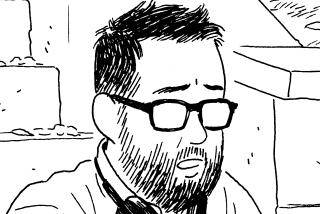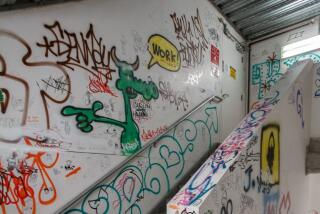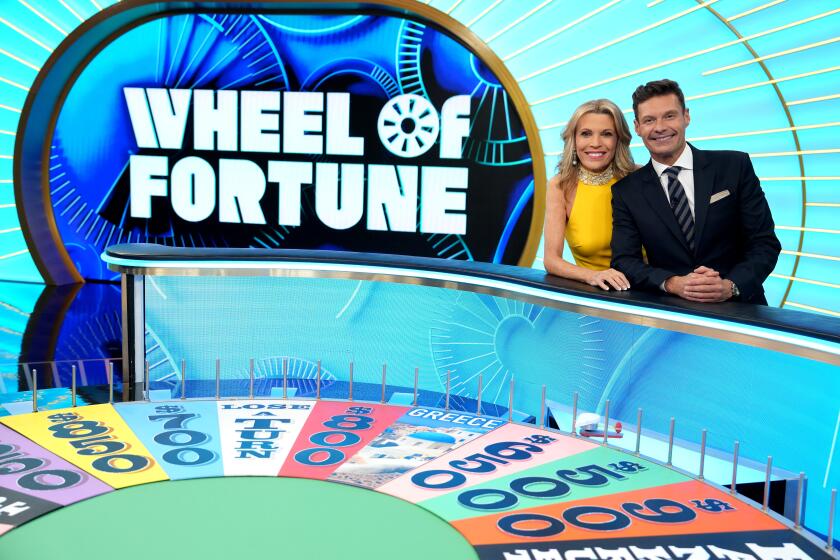Biting the bullet
When words alone weren’t enough to drive home his point, Ben Franklin grabbed for the inkpot and sketch pad. He drew a snake severed into eight pieces. “Join or die,” said the caption, a play on the superstition that a snake would survive if its pieces were put together before sundown. Franklin labeled the sections of the creature as states; -- the drawing was an argument for a union of states.
Published on May 9, 1754, in the Philadelphia Gazette, this is believed to be the first political cartoon in an American newspaper.
For the record:
12:00 a.m. Aug. 25, 2004 For The Record
Los Angeles Times Wednesday August 25, 2004 Home Edition Main News Part A Page 2 National Desk 1 inches; 34 words Type of Material: Correction
Political cartoons -- A story in about editorial cartoonists in Tuesday’s Calendar said the newspaper in which Ben Franklin’s original American political cartoon was published was the Philadelphia Gazette. It was the Pennsylvania Gazette.
In the 250 years since, of course, Franklin’s united states prospered. So did the single-panel editorial cartoon as a fixture of American newspapers, but no longer. The new millennium has brought a decline in grand tradition of punctuating our civic debates with a splash of ink in the face.
The number of cartoonists employed full time at newspapers is shrinking. Simultaneously, what some see as the inconsequential “joke” cartoon threatens to supplant the bared fangs of the Franklin-style “argument” cartoon.
Although casual newspaper readers may hardly notice the trend amid the larger whirlwinds of the media revolution, those who study and practice the art of editorial cartooning ask themselves whether this is one of those emerging signposts of the times worthy of pause and reflection. Just what might we be losing, anyway?
“When I go to a gathering of editorial cartoonists, I feel like I’m at a convention of buggy-whip makers in the 1920s,” said Stephen Hess, senior fellow emeritus of the Brookings Institution and coauthor of “Drawn & Quartered: The History of American Political Cartoons,” a 1996 book from which the Franklin anecdote was taken.
Like others who relish the political sass of editorial cartoons, Hess described himself as “damned mad” at the turn of events in contemporary newspapers. At the same time, though, he remained vaguely hopeful that the Internet will manage, somehow, someday, some way, to salvage the art.
After all, he noted, those who are really hungry for cartoons can feast on them for hours a day, thanks to the Web. For instance, a tour through Daryl Cagle’s website at Slate magazine, https://cagle.slate.msn.com, brings the world’s cartoonists online, by topic or by artist -- collections that are variously moving, zany, incendiary, celebratory and hilarious. Assembled like this, cartoons have a punchy, cartoon-like way of making the argument for their own value in America’s civic conversation.
Online compendiums have brought to light something else about the craft. When cartoonists aim their sketch pens toward New York and the Republican National Convention starting Monday, they will be mindful that for all their imagination, they sometimes have a way of thinking alike. When five or more similar cartoons on the same subject appear simultaneously in print, Cagle labels it a “Yahtzee” after the board game of the same name. The “greatest” Yahtzee occurred in the aftermath of Sept. 11 when at least 38 cartoonists drew versions of a weeping Statue of Liberty. Among them was Cagle.
Fun on the Web does not feed the family, however. And Cagle, who also is Slate’s cartoonist, is hardly sanguine about the foreseeable future for cartoonists online. Apart from his job, there aren’t many proven ways for serious cartoonists -- and no, from the journalists’ point of view that’s not an oxymoron -- to earn a living from the Internet. Meanwhile, he said, the decline in paying newspaper jobs and the spread of gag cartoons “is leading to the slow death of a great American art form.... What we are seeing is a general decline in the profession.”
Taking measure of contemporary cartooning is an imprecise matter. Fewer cartoonists are employed by newspapers now than a decade ago, virtually everyone familiar with the craft agrees. But how many fewer is not so easily determined. In conversations with cartoonists and sundry experts, one hears estimates that about 80 to 90 men and women are employed full time as editorial cartoonists today, down from maybe 150 to 200 in the 1980s and ‘90s. But these are not figures from a survey or census, and they generally exclude freelancers and sometimes don’t account for part-timers, such as newspaper graphic artists who also contribute to the cartoon supply.
Whatever the precise numbers, editorial cartoonists constitute one of the tiniest occupational categories in the country. The American Farriers Assn., for instance, has a membership list of professional blacksmiths that is 30 times as big as the roster of the Assn. of American Editorial Cartoonists. And, it can be noted, the demand for blacksmiths has been increasing.
A chill in the air
With ranks so small, an unfilled vacancy of just one or two cartoonists’ jobs is enough to send fear through the profession, and that’s precisely the state of affairs now. The Chicago Tribune (which, like the Los Angeles Times, is owned by Tribune Co.) has not replaced Jeff MacNelly, the nationally known cartoonist who died in 2000.
“All I can say is that the position remains open. In the meantime, I choose cartoons from the best syndicated cartoonists in the business,” said Bruce Dold, editorial page editor.
The Buffalo News lost its Pulitzer Prize-winning cartoonist, Tom Toles, to the Washington Post in the spring of 2002 and only recently replaced him with a man who does double duty as a graphic artist for the paper. Here and there, established cartoonists cite other examples where commitments to this old staple of newspapers remain in doubt. Combined with periodic budget cutbacks in the newspaper industry, cartoonists extrapolate and dig for their antacids.
Equally alarming to those in the field, or more so, is the drift toward softer, sometimes sillier editorial cartoons. Again, this is a matter of subjective impression rather than firm arithmetic, but those who follow the craft say there is no mistaking the trend: Increasing numbers of today’s editors and cartoonists favor a chuckle over an argument.
“The problem in the profession is that we’re moving away from the message of cartoons and engaging in ‘Tonight Show’ humor,” said Los Angeles Times cartoonist Michael Ramirez, whose own fire-breathing, ideologically charged style is the very opposite of soft, as was his predecessor’s, Paul Conrad. “It’s corrupting the profession. It’s no wonder that some people aren’t taking us seriously when some of us no longer take the responsibility seriously.”
Ramirez said he instructed his syndicate not to offer his work to Newsweek because the magazine’s Periscope section reprints cartoons that too often pull punches, a complaint that is voiced by other traditionalists in the business.
“Why would you say so little when you can say so much?” Ramirez asked.
One need look no farther than the Op-Ed page of this newspaper for examples of the contrasting approaches in cartooning. A recent Ramirez cartoon caricatured a familiar jowly face with the pungent caption: “Michael Moore or Less....” Later in the same week, a syndicated cartoon depicted George Bush and John F. Kerry both helping a man take his bath. In a quip certain to provoke no one, the man says, “I hate being an undecided voter.”
“Nothing wrong with humor,” remarked Ramirez. “Humor is a great thing, a very effective tool. But if you take the message out, you have just a cartoon, not an editorial cartoon.”
Last year in a development that cartoonists found particularly foreboding, St. Louis Post-Dispatch cartoonist John Sherffius resigned after what was reported to be a clash with his editors over the partisan edge of his cartoons. At the time, Sherffius was quoted as saying, “I felt that ultimately my cartoons were not a good fit for the page.” He has declined to discuss matters further in public, but other cartoonists say the chill is still felt coast to coast.
Penetrating insights
Reasons for the changing fortunes of editorial cartoons are, in equal measure, obvious and speculative.
What’s obvious is that newspaper executives, in keeping with corporate trends, have become ever more earnest in their determination to hold rein on budgets for the sake of earnings. Modern technology and syndication allow newspapers to offer a range of high-quality editorial cartoons without payroll expenses, bad news for the craft in which fewer than one in 10 newspapers employs an editorial cartoonist now.
“The price of cost-cutting and buying from syndicates is that we’re losing local cartoons,” said Sandy Northrup, a Washington, D.C., journalist and filmmaker who is coauthor of the book “Drawn & Quartered.” “Cartoonists are having a harder and harder time finding gainful employment.”
More speculative is the extent to which other industry and social trends work against the profession.
The very thing that makes editorial cartoonists stand out in journalism may also account for their being targets now: their skill at penetrating the skin and jabbing raw nerves. Editorial cartoonists are famed for bringing in bags of scalding letters to the editor. Publishers and editors sometimes wince, but the good ones are expected to honor covenants that hold this interchange to be part of a newspaper’s role in a community -- stirring the civic kettle.
Last April, when Matt Davies won the Pulitzer Prize for cartooning at the Journal News in White Plains, N.Y., publisher Gary Sherlock enthused, “He is provocative, he makes people think, and that’s what it’s all about.”
Tradition aside, however, this is an era when public sensibilities are easily offended and news consumers have vast media choices. Cartoonists say they are having a harder time winning the argument for placing a well-sharpened barb on readers’ doorsteps every few days.
“Newspapers are, more and more, being run by corporations, by people who don’t always understand the value of generating dialogue,” said Bruce Plante, cartoonist for the Chattanooga Times editorial page.
Evidence of changing priorities is as handy as the nearest newspaper. While holding the line or cutting budgets for cartoons, executives have poured resources into visual makeovers. The aim is chiefly to attract and hold younger readers whose tastes have been shaped in an age of imagery. Cartoonists fume at being largely left out of the action since their work provided the original visual punch to a newspaper.
“What they should be doing is adding more cartoons, not less,” said an exasperated Kevin Kallaugher, cartoonist for the Baltimore Sun, also owned by Tribune Co., and the Economist magazine.
Instead, newspaper editorial pages have brought up the rear in the modernizing trend, and younger readers are losing touch with editorial cartoons.
For Kallaugher, the moment of realization came when his son enrolled at Yale and was housed in the same dorm as Garry Trudeau’s daughter. Kallaugher mentioned the coincidence and recalled his son’s reaction at hearing Trudeau’s name:
“Who?”
“I told him, ‘You know, “Doonesbury.” ’ “
The son replied, “What’s ‘Doonesbury’?”
“Newspapers,” said Kallaugher with a sigh, “are not in these guys’ vocabulary.”
Cartoonists aren’t taking it sitting down. Some are stretching the old and often hidebound form, adding color, using multiple panels and expanding the use of dialogue instead of one-liners -- much as Trudeau has done with “Doonesbury,” part comic strip and part editorial cartoon. Long-time students of cartooning, including Poynter Institute faculty member Howard Finberg, encourage the trend, asking whether “it’s time to reinvigorate” cartoons, not just for the sake of readers but to keep apace of changing times and to “revitalize the interest of editors.”
Meanwhile, the Assn. of American Editorial Cartoonists is preparing to undertake a three-year campaign, with support from the foundation of the late cartoonist Herbert Block -- the legendary Herblock -- to promote editorial cartoons in classrooms and newsrooms.
Cartoonists will be asked to rise from their drawing tables and assist schoolteachers in explaining the craft, heritage and language of editorial cartooning to a new generation. Then, to raise the profile of cartoonists within their own industry, the association plans to send representatives to national and regional meetings of editors and publishers, hoping to prove that subscribers look first and read second when it comes to the editorial page.
The association’s president, Matt Davies of the New York Journal News, explained, “We’re not just court jesters, you know.”
More to Read
The biggest entertainment stories
Get our big stories about Hollywood, film, television, music, arts, culture and more right in your inbox as soon as they publish.
You may occasionally receive promotional content from the Los Angeles Times.










